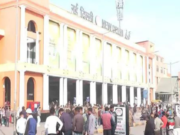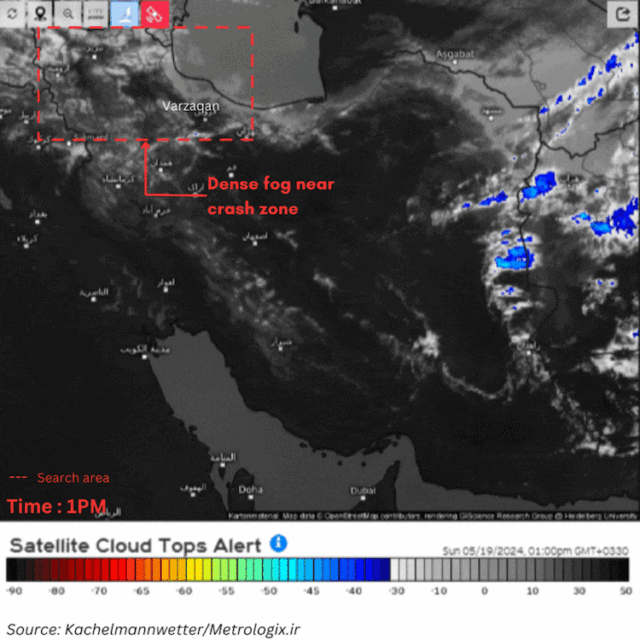
A Bell 212 helicopter carrying Iranian President Ebrahim Raisi and the country’s foreign minister were killed in a crash in the country’s mountainous northwest region near the Azerbaijan border on Sunday.
Prime Minister Narendra Modi tweeted he was “shocked by his tragic demise” and that his “contribution to strengthening the India-Iran bilateral relationship will always be remembered”.
The 63-year-old Iranian President was en route from the Iran-Azerbaijan border after inaugurating a joint dam project when the helicopter, carrying him, Foreign Minister Hossein Amir-Abdollahian, East Azerbaijan Governor Malek Rahmati, and senior cleric Ayatollah Al-Hashem, crashed near Varzaghan around 1 pm (local time).
Iran’s semi-official news agency IRNA said the crash killed eight people in total, including three crew members aboard the helicopter, which Iran purchased in the early 2000s. The incident occurred amidst adverse weather conditions and dense fog.
The search and rescue operation extended over 10 hours through dense forests and rugged mountainous terrain. The president of the Iranian Red Crescent Society, Pir-Hossein Koulivand, said 40 search teams were on the ground despite “challenging weather conditions”.
It was “impossible to conduct aerial searches” via drones because of the adverse weather, Koulivand said, according to IRNA.
On Monday, Turkish authorities released drone footage showing a fire in the mountains that they “suspected to be the wreckage of a helicopter”. The coordinates listed in the footage put the fire scene about 20 kilometres south of the Azerbaijan-Iranian border on the side of a steep mountain.
After an hours-long search hampered by fog and rain, on-foot rescuers found the burnt-out wreckage of the helicopter. The chief of the Iranian Red Crescent said rescuers found “no signs of life” on the site.
Initially, a triangular search area covering approximately 10 square kilometres between the villages of Uzi, Sungun and Pir Davood was identified. Some 10 hours later, the wreckage was discovered near the centre of this zone. Based on the approximate vegetation signature and ridgeline, the crash site’s location was pinpointed at an altitude of 4,450 metres.
According to reports, the accident was caused by a sudden weather change in Dizmar, the district where the helicopter crashed. Iran’s interior minister Ahmad Vahidi later described it as a “hard landing due to poor weather conditions”.
A “hard landing” is when an aircraft lands harder and faster than it should, because of the weather, pilot errors, or mechanical issues.
Publicly available satellite data shows the area of the crash enveloped in heavy fog starting at 1 pm on May 19.
Images and videos from the site confirm that President Raisi and his companions were riding a US-manufactured Bell 212 helicopter.
Manufactured by Bell Textron Inc., an American aerospace manufacturer headquartered in Fort Worth, Texas, the Bell 212 is one of its iconic models, making it a significant part of Bell Textron’s helicopter lineup.
Data from flight tracking platforms show that nearly 2.8 million users tracked the Turkish UAV assisting in the search operations for over 14 hours.
After discovering the charred bodies of the Iranian President, the drone operator drew a star-and-crescent sign on the flight path.
FUTURE OF IRAN
Raisi was seen as a protege to Iran’s Supreme Leader Ayatollah Ali Khamenei and a potential successor for his position within the country’s Shiite theocracy.
Article 131 of the Islamic Republic’s Constitution says that if a president dies in office, the first vice-president – in this case, Mohammad Mokhber – takes over, with the confirmation of the Supreme Leader, who has the final say in all matters of state in Iran.
A council consisting of the first vice-president, the Speaker of Parliament and the head of the judiciary must arrange an election for a new president within a maximum period of 50 days.
ISRAEL ON ALERT
Amid heightened tensions with Iran, Israel has reportedly disrupted GPS systems in its central parts with interference noted in others parts of the country as well, as per data by GPS interference monitoring website GPSJAM.
Last month, the country admitted to using GPS blockers, also called spoofing, as a defensive measure amid heightened tensions with Iran and its allies in the Middle East.













































